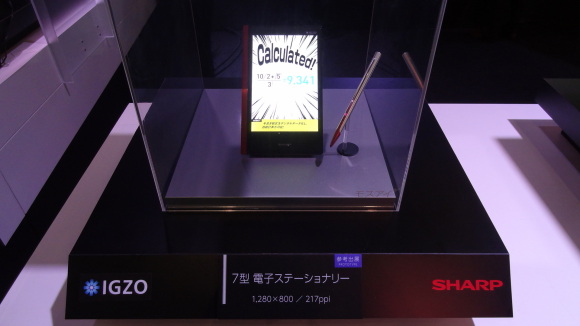
Image via Tech Hive
Is Sharp showing high-res iPad mini screens? "The Japanese manufacturer, which has been mass producing the screens since August for an unnamed customer, is showing working tablet displays in 7-inch, 10-inch, and 13-inch form factors at its booth, though they are sealed off behind glass. IGZO technology, named after the indium gallium zinc oxide semiconductor on which it is based, can be used to make screens with smaller pixels that draw far less power than current models with more accurate touch sensitivity. Sharp is pushing the technology for smartphones and tablets." via Tech Hive
What Is the Society for Information Display For? "What sort of information should be presented and how can we prevent human overload? These and many more questions seem relevant to the Society for Information Display. SID should not just be about displays, but about display-based solutions." via Display Central
Sharp tackles reflected light with 'moth eye' LCD "Sharp applied an anti-reflecting coating to its LCD panels based on technology similar to the nanostructure of a moth’s eyes. Scientists have long understood that moth eyes have a special property that eliminates reflection. The surface of a moth's eyes is covered with bumps and valleys that absorb oncoming light, enhancing night vision." via EE Times
Average Size of LCD TV Panels Increases by 2 Inches in 12 Months "Overcapacity in the TFT LCD industry remains an ongoing concern for panel makers. Capacity expansions have been slowing down, with few new investments in Korea, Taiwan and Japan. ...In addition to shrinking capacity, an important factor in bringing supply and demand into balance is area growth. One key trend to watch here is average screen size, especially for TV panels." via DisplaySearch Blog
Do you need display panels? Ask Jason. I'm the managing editor of Display Alliance but I also source panels for Mass Integrated, Inc. Just let me know what you need: jason@displayalliance.com
Reading on LCD vs e-Ink displays: effects on fatigue and visual strain "Since research has shown that, compared to reading on electronic displays, reading on paper is faster and requires fewer fixations per line, one would expect differential effects when comparing reading behaviour on e-Ink and LCD. In the present study we therefore compared experimentally how these two display types are suited for reading over an extended period of time." via NCBI
Hitachi Electronic Devices becomes KOE-Americas "“Hitachi has a long history of firsts in LCD technology” says Keith Brown, vice-president of operations and sales for KOE Americas. “From the first commercially available in-plane switching technology, to the first ultra-wide-temperature range displays, Hitachi has been an industry innovator for over three decades. KOE-Americas hopes to build on that legacy by partnering with product developers to utilize LCDs in new and innovative ways.”" via Electronic Products and Technology
CEATEC 2012: Docomo demos hands-free video-conferencing prototype with digitized avatar "Docomo came with something rather interesting in the shape of a pair of glasses that comes with 7 different 720p cameras. Not only these cameras will digitize your face, but will also capture in real time your surrounding environment and movements to your calling partner." via Akihabara News
HDTV buying guide: How to select the right set "Though the majority of LED sets you’ll find are edge-lit, meaning that the array of LED backlights behind the LCD panel are positioned around the edges of the set, more-expensive LED sets use full-array or backlit LED light sources. Backlit or full-array sets are more expensive to make (and buy), and they’re generally quite a bit thicker than edge-lit LED sets. Some of these higher-priced backlit LED sets feature a technology called local dimming." via TechHive
The future of brain-computer interfaces revealed ""A BCI is a system that enables interaction with a computer based on changing electrical signals that occur in the brain," Carmichael tells us. "The signals can be taken invasively or non-invasively either from inside the brain or from the scalp. Non-invasive BCI takes signals that are present at micro-volt levels on the scalp and then amplifies them using an EEG. These signals are then digitised so that they can be used by the computer."" via Tech Radar
Minority Report Touch Gestures A Terrible Idea, Says Top Industrial Designer "In the movie, Tom Cruise is doing a lot of object selection, sorting, and editing. Those things work best with small hand movements. We require more motor control for that kind of work. But there is an emerging field of computing that does take advantage of more ‘phatic’ interactions." via Sixteen:Nine
Want to submit news to Display Alliance or be interviewed? Get in touch with us: jason@displayalliance.com
New Technologies and Methods Push Imaging Capabilities "Imaging used to be simply defined as the representation of an object's external form. That definition no longer holds true as researchers now look for more than just an image. They look for more information within an image, such as fluorescent tags, mechanobiological parameters, internal structures, fabrication while imaging and the characterization of materials as yet undefined. " via Laboratory Equipment